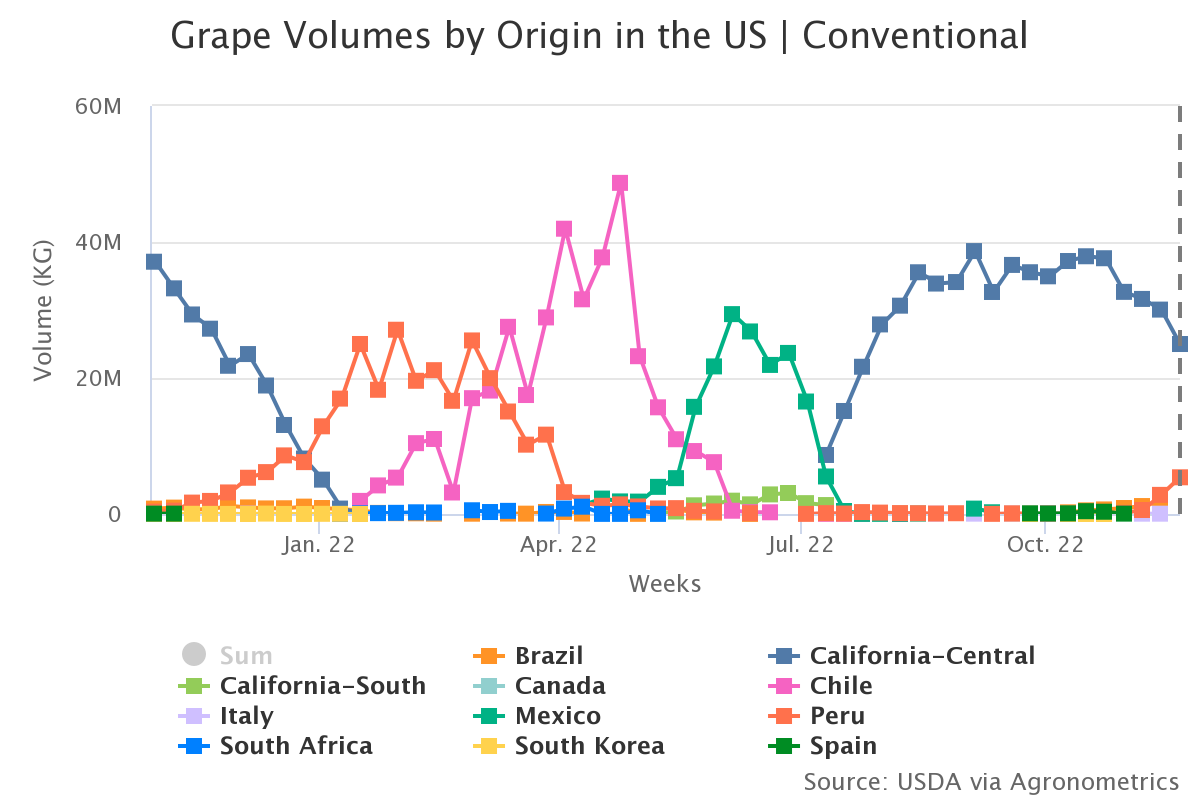Agronometrics in Charts: Mexican table grape volumes 3% lower than last season

In this installment of the ‘Agronometrics In Charts’ series, Valeria Concha studies the state of the US Table Grape market. Each week the series looks at a different horticultural commodity, focusing on a specific origin or topic visualizing the market factors that are driving change.
According to the USDA GAIN report published on November 17, 2022, the table grape production in Mexico is projected at around 347,000 tonnes, 3% less than last season. The planted area for the 2023 season is estimated to be 8% below 2022. Farmers find it difficult to obtain funding to switch to new grape varieties, and to incorporate technology in the field for efficient use and control of water to address drought and climate change-related pressures. Farmers also face higher input costs to produce grapes and consider planting more profitable horticultural crops. Many growers, while grapes may be their primary product, have already diversified into other vegetable and fruit crops.
Exports from Mexico in the 2023 season are projected at around 196,000 tonnes, not much different from the 2022 season. With production and consumption projected to be lower, exportable supply remains relatively stable. Most of Mexico's table grape production is exported to the United States.
Source: USDA Market News via Agronometrics. (Agronometrics users can view this chart with live updates here)
The season 2022 ranked as one of the most difficult seasons ever recorded in Mexico’s history. The current logistical crisis caused the quality of the grapes to be affected and prices to fall. The Local Agricultural Association of Table Grape Producers of Mexico (AALPUM) explained that shipping delays caused damage to the sector, with a drop in the quality of black and red grapes and a decrease in prices of up to 30% compared to the previous season. Juan Alberto Laborin, general director of the association, said that “we had an accumulation of black grapes from Chile and Peru because the ships, ports and fumigation chambers were saturated. Therefore, we started with a season full of a lot of fruit. There was an impressive market saturation, with products that were late and of poor quality, for example, in Long Beach port (USA) we spent days waiting to unload the ships”.
 Source: USDA Market News via Agronometrics.(Agronometrics users can view this chart with live updates here)
Source: USDA Market News via Agronometrics.(Agronometrics users can view this chart with live updates here)
In the view of John Pandol, director of special projects for Pandol Bros., Inc., Delano, CA, this winter European and Asian markets are expected to import “the same volume, or a little less” from Peruvian and Chilean grape shippers. Given this scenario, those South American shippers will likely be looking to increase export volumes to the U.S. Pandol said that the inelastic European market only absorbs a certain volume and beyond the program amounts, there is very little additional market. In contrast the US has regional independent supermarket chains that can respond to increased volumes and do this to compete against the big program buyers. Those in the winter grape business “are still feeling burned fingers” after Peruvian fruit stacked atop the peak Chilean volume early in 2022. The inclination now is to move Peruvian grape volume early to avoid another collision with Chile.
Source: USDA Market News via Agronometrics. (Agronometrics users can view this chart with live updates here)
In our ‘In Charts’ series, we work to tell some of the stories that are moving the industry. Feel free to take a look at the other articles by clicking here.
All pricing for domestic US produce represents the spot market at Shipping Point (i.e. packing house/climate controlled warehouse, etc.). For imported fruit, the pricing data represents the spot market at Port of Entry.
You can keep track of the markets daily through Agronometrics, a data visualization tool built to help the industry make sense of the huge amounts of data that professionals need to access to make informed decisions. If you found the information and the charts from this article useful, feel free to visit us at www.agronometrics.com where you can easily access these same graphs, or explore the other 21 commodities we currently track.














































